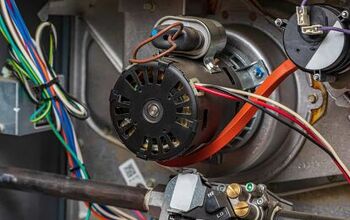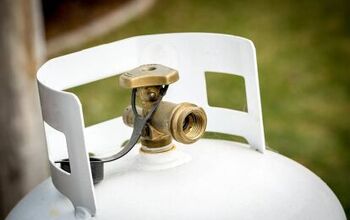Furnace Tries To Start But Then Shuts Down? (We Have A Fix)

A furnace that isn’t working problem is more than just an annoyance. Any problem with your furnace can indicate issues that are potentially dangerous to you and your family. A furnace that tries to start and then shuts down requires immediate attention.
A furnace that tries to start and then shuts down suffers from what is known as short-cycling. Several problems can cause a furnace to short-cycle, such as a restricted air-flow. Faulty sensors can also cause short-cycling, as can an improperly sized heater. These are the most common problems causing short-cycling. Other factors can cause short-cycling, but they are rare.
Short-cycling of your furnace is a serious situation you shouldn’t ignore. Some of the more common problems that cause short-cycling of a furnace can be diagnosed and remedied by most homeowners. A few simple steps can help you diagnose and remedy some of the problems associated with furnace short-cycling.
Do You Need Furnace or Heating System Repair?
Get free, zero-commitment quotes from pro contractors near you.

Understanding the Problem to Find the Problem
To accurately diagnose a short-cycling problem with your furnace, it is important to understand how your furnace operates. With this understanding, the steps required to diagnose and remedy a short-cycling situation will make more sense.
The Three Ingredients for Combustion
Your gas furnace needs three things to work properly. The lack of any of these ingredients will interrupt the combustion process that keeps your gas furnace operating. Your furnace needs
- Fuel
- Air
- An ignition source
The Ignition Source
There must be an ignition source to start the fuel and air burning in the combustion chamber of your furnace. In older furnaces, this ignition source is a pilot light. Newer furnaces use an electrically operated igniter that creates a spark near the burner when the fuel valve opens.
The Fuel
The most popular fuel for furnaces in homes in the United States is gas. The gas can be propane, butane, or liquid petroleum gas (LPG). LPG is the grass delivered to your home by pipes.
Air, or More Appropriately Oxygen
The third component is air. The fuel needs oxygen in the air to burn. Without oxygen, the fuel cannot ignite or remain burning. Lack of oxygen can be a dangerous situation as well. A furnace starved of air may not operate properly and may generate high levels of poisonous carbon monoxide.
Making Sure your Furnace is Getting Enough Air
If your furnace is short-cycling, it may not be getting enough air to operate properly. Several things can inhibit combustion air in your furnace. Fortunately, these problems are easy to diagnose and repair for most homeowners. Our step-by-step instructions will help you perform this inspection systematically.
Step 1: Check for a Blocked Combustion Air Intake
Most new furnace installations include an outside air intake to provide combustion air for your furnace. Most of these installations use an air pipe that extends up through the ceiling and roof. Unheated or cooled air is fed to your furnace to support the combustion process.
If this air intake pipe is clogged or blocked, your furnace can begin to short-cycle. Check the outside air intake in your furnace closet to ensure an unrestricted flow of combustion air to the furnace. If necessary, clean the intake pipe or adjust the roof cap on the pipe.
Step 2: Ensure Adequate Air Flow Around Your Furnace
The space around your furnace must be clear and free of any obstructions. You shouldn’t use your furnace closet to store anything. Not only does this pose a fire hazard, but it can also cause air supply problems to the furnace.
Your furnace also has minimum offsets from walls. Air must circulate around the furnace for proper functioning. If the furnace is too close to walls or other objects, air-flow disruptions occur, and your furnace may not get the air it needs to operate correctly.
The user manual supplied with your furnace should have more information about minimum distances and offsets for correct installations. You may need to consult with a plumber if your furnace needs to be moved or reinstalled correctly.
Step 3: Inspect the Air Intakes on your Furnace
Inspect the openings in your furnace that allow air to flow freely to the combustion chamber. These openings can become clogged with dirt, lint, and other debris over time. A quick vacuuming is often the answer if there is significant build-up on these openings.
Never stack or store anything around your furnace that can shift or block the air intake openings. It is a good policy not to use your furnace closet for storage of any kind.
Step 4: What Goes in Must Go Out – The Exhaust Flue
Even if your furnace is getting plenty of air to combust properly, it may begin to short-cycle if the hot gases created cannot escape. The exhaust flue on your furnace allows the hot combustion gases to escape outside safely.
Checking the exhaust flue may require a plumber. There are safety issues involved when removing or replacing an exhaust flue. If not done properly, poisonous gas can enter your home and pose a health threat to you and your family.
If you suspect that the exhaust flue on your gas-fired heater is blocked or restricted, make an appointment with a plumber to inspect your furnace and repair the flue if necessary.
Step 5: Dirty Air Filters – A Common Culprit
Believe it or not, a dirty air filter on your furnace can cause short-cycling. If your furnace cannot get enough airflow through the vents, the heating system’s air will get too hot. Sensors in the combustion chamber will trigger, and the furnace will shut down.
Check the air filters in your furnace. Change your air filters regularly, often as much as once a month. The owner’s manual for your furnace has more specific information about the type of furnace filter to use and the frequency of changes.
Furnace Starts Then Stops
No Air Problem? 4 Other Possible Causes for Short-Cycling
There are several other possible causes for a furnace to light and then shut down. Most of these problems are best left to a professional HVAC technician to diagnose and repair.
1. Furnace Overheating
Your furnace may be getting too hot. Modern gas-fired furnaces have several internal sensors that continually monitor the interior temperature of the furnace. These sensors won’t allow the furnace to operate if any of these internal parts exceed a pre-set temperature.
If one of these sensors is faulty, it may send bad readings to the control board and keep your furnace from operating properly. A bad sensor can result in short-cycling of the furnace.
Unfortunately, finding and testing these sensors is beyond the scope of most homeowners. Call your HVAC technician for a service visit.
2. Flame Sensors – Keeping the Home Fires Burning
Your furnace has a flame sensor as a safety precaution. The flame sensor controls the gas valve on your furnace. If the flame sensor tells the gas valve that the flame is burning, the valve remains open.
A defective flame sensor will allow the burner to light but then sends a signal to the gas valve that the flame is not burning, and the gas valve closes. This situation results in a classic short-cycle in your furnace.
If the flame sensor on your furnace is faulty, have it replaced by a qualified HVAC technician. The flame sensor must be positioned in the burner correctly and calibrated for your furnace.
3. An Improperly Sized Furnace – When Bigger is Not Better
Many people think that a bigger furnace equals more efficiency and better heating. Nothing could be further from the truth. A heater that is too big for the space it is serving often short-cycles as a result.
The furnace heats the space too quickly. The result is frequent starts and stops of the furnace. Short-cycling of this type leads to a shorter life of the furnace and less efficient operation. It requires more energy to start the motors on your furnace than running them once they are operating.
A qualified HVAC technician can evaluate your home size and heating needs and make recommendations for properly sizing a furnace installation.
4. Thermostat Location
A thermostat in the wrong place can often lead to a furnace that short-cycles. If your thermostat is exposed to sudden fluctuation in temperature, it can send bad signals to your furnace. Avoid placing thermostats in places such as:
- Exterior walls
- Near windows or outside doors
- Under or near heating and cooling vents
- Kitchens
- Bathrooms
- Other heat sources such as fireplaces
A qualified and trained HVAC technician can help you find the best location for your thermostat. Rerouting the thermostat wiring is often complicated and difficult and is best performed by an experienced service technician.
Do You Need Furnace or Heating System Repair?
Get free, zero-commitment quotes from pro contractors near you.

Don’t Ignore A Furnace that Comes on and Then Shuts Down
Running a furnace that is short cycling is never a good idea. It puts a strain on the furnace. More importantly, a short-cycling furnace is a symptom of bigger problems. Some of these problems are potentially dangerous for you and your family.
We hope that the information in this article helps you diagnose and remedy problems that cause furnace short-cycling. We encourage you to seek the help of qualified professionals for problems in most cases involving gas-fired appliances. Stay safe and stay warm.

Dennis is a retired firefighter with an extensive background in construction, home improvement, and remodeling. He worked in the trades part-time while serving as an active firefighter. On his retirement, he started a remodeling and home repair business, which he ran for several years.
More by Dennis Howard











![10 Best Electric Lawn Mowers - [2022 Reviews & Top Rated Models]](https://cdn-fastly.upgradedhome.com/media/2023/07/31/9070486/10-best-electric-lawn-mowers-2022-reviews-top-rated-models.jpg?size=350x220)

![10 Best Zero Turn Mowers – [2022 Reviews & Ultimate Buyer's Guide]](https://cdn-fastly.upgradedhome.com/media/2023/07/31/9070522/10-best-zero-turn-mowers-2022-reviews-ultimate-buyer-s-guide.jpg?size=350x220)













